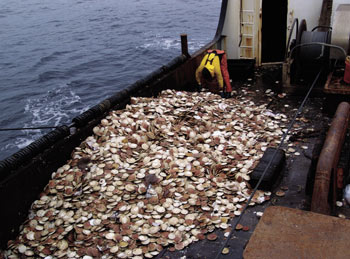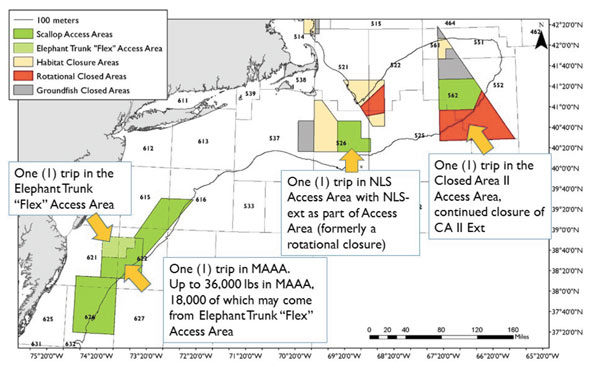Council Approves Scallop Framework 28 with 2017-2018 Specs

In short, the 2017 Atlantic sea scallop fishery is expected to generate landings comparable to 2016. The primary difference is that more of the poundage will come out of access areas rather than open areas. Full-time vessels will be allocated four access area trips in 2017 compared to three trip in 2016; and Full-time vessels will be allocated 30.41 open area days-at-sea, down from the 2016 allocation of 34.55 days. NOAA photo
The New England Fishery Management Council yesterday approved Framework Adjustment 28 to the Atlantic Sea Scallop Fishery Management Plan. The framework establishes specifications for the 2017 fishing year and sets default specifications for 2018.
If the framework is approved by the National Marine Fisheries Service (NMFS), full-time limited access scallop vessels in 2017 will be allowed to make four 18,000-pound “scallop access area” trips – one into the Nantucket Lightship Access Area, one into the Closed Area II Access Area, and two into the Mid-Atlantic Access Area (MAAA) with the option of making one of those Mid-Atlantic trips in the newly created Elephant Truck “Flex” Access Area (light green in chart). The Elephant Trunk Flex Area will be subject to a seasonal July 1-Sept. 30 closure. Part-time limited access vessels will be allowed to make two 14,400-pound trips into the available access areas, one of which must be in the Mid-Atlantic Access Area.
The Council approved a 2017 Northern Gulf of Maine TAC of 95,000 pounds, up from 70,000 pounds in 2016. However, the 2017 TAC will need to be adjusted to account for a 2016 overage. As a result, the Northern Gulf of Maine quota that will be available to the fishery on March 1, 2017 likely will be on the order of 75,000 pounds.
Framework 28 initially proposed to allocate 29.18 “open area” days-at-sea to full-time limited access vessels. Under the 13-month proration schedule and the automatic reduction that allows vessels to steam off of the days-at-sea clock south of Cape May, full-time vessels will be allocated 30.41 open-area days. Part-time vessels will be allocated 12.16 days-at-sea under the prorated schedule, up from the initial 11.67 allocation that resulted for a 12-month fishing year.
The Council agreed to base these allocations on spatial management – an approach that uses projected landings – under the existing allocation split between the two components of the fishery:
• 94.5% for the limited access component of the fishery; and
• 5.5% for the limited access general category individual fishing quota (IFQ) component.
For 2017, this means the IFQ fishery will be allocated 2.43 million pounds – prorated for 13 months at 2.49 million pounds – and 5.5% of the access area allocations. These trips will be equally distributed across all access areas, but the Closed Area II trips, which are a long haul for some general category boats, will be prorated 50% to the Nantucket Lightship area and 50% to the Mid-Atlantic/Elephant Trunk Flex Access Area, which are easier to steam to.
Also as part of Framework Adjustment 28 to the scallop plan, the Council agreed to:
• Limit research set-aside compensation fishing to the Mid-Atlantic Access Area and open areas, excluding the Northern Gulf of Maine Management Area;
• Restrict the possession of shell stock inshore of the days-at-sea demarcation line north of 42°20’ N latitude to 50 US bushels, as is already the case south of the line;
• Adopt 2018 default specifications equivalent to 75% of the 2017 open area days-at-sea allocations for full-time vessels with one 18,000-pound Mid-Atlantic Access Area trip. The limited access general category IFQ component will receive 75% of the 2017 quota allocation, access area trips equivalent to 5.5% of the default access area allocation.

The 2017 scallop fishing year will begin on March 1 but the 2018 fishing year will begin April 1. This means the 2017 fishing year will be 13 months long. To accommodate this adjustment, the Council agreed to prorate open area days-at-sea allocations by an additional 4.7% to cover 13 months. Exception: Specifications for the Northern Gulf of Maine Management Area will not be prorated. The fishery there operates under a hard total allowable catch (TAC) and proration was not recommended by the Council’s Scallop Committee. NOAA graphic
Groundfish Actions Impacting Scallopers
During its Groundfish Committee report, the Council addressed two issues that impact the Atlantic sea scallop fishery:
•Northern Windowpane Flounder – The Council voted to develop a Gulf of Maine/Georges Bank northern windowpane flounder sub-annual catch limit (sub-ACL) for the scallop fishery under Framework Adjustment 56 to the groundfish plan. The sub-ACL will be a fixed percentage based on the 90th percentile of 2005-2014 scallop catch rates of northern windowpane. Under this formula, the scallop fishery will be allocated 21% of the total acceptable biological catch for this stock, which then will be reduced by 7% to account for uncertainty to determine the scallop fishery’s sub-ACL. The scallop fishery currently is not subject to a sub-ACL or accountability measures for northern windowpane, so this step represents a change for scallopers, assuming the action is approved by NMFS. The Council will be developing accountability measures for northern windowpane for fishing year 2018.
•Accountability Measures (AMs) – The Council also voted to temporarily modify the existing AM policy for the scallop fishery for a two-year period so that accountability measures onlywill apply when the scallop fishery exceeds its sub-ACL for a groundfish stock andthe overall ACL for that stock is also exceeded. The Council approved this temporary modification for both the George Bank yellowtail flounder and northern windowpane flounder stocks. Under current regulations, AMs also are triggered when the scallop fishery exceeds its sub-ACL by 50% and the overall ACL is exceeded. This new change removes the 50% trigger for the 2017 and 2018 fishing years.
For more information, contact Scallop Plan Coordinator Jonathon Peros at (978) 465-0492 ext. 117, email jperos@nefmc.org. Or visit the Council’s scallop webpage at http://www.nefmc.org/management-plans/scallops.
